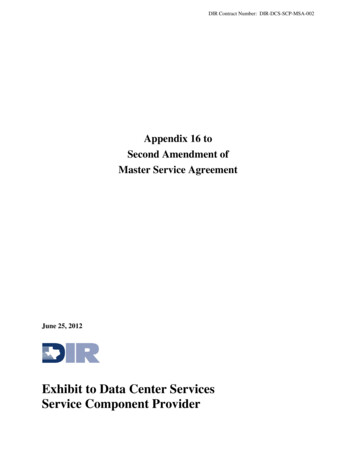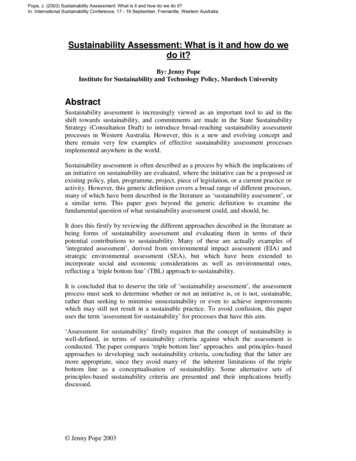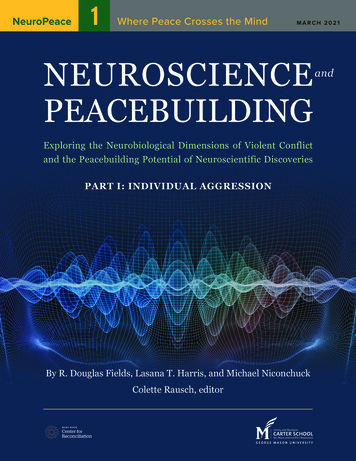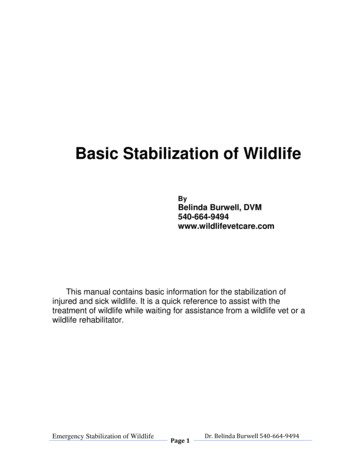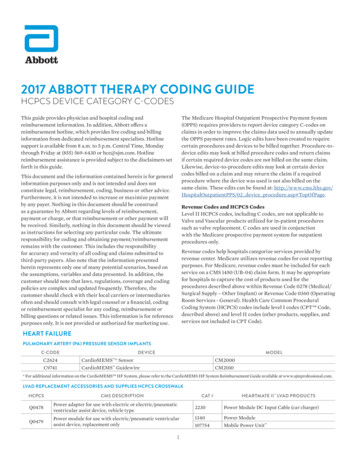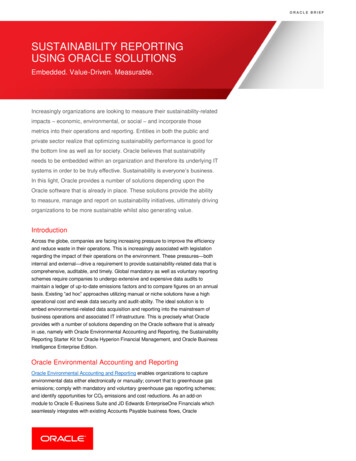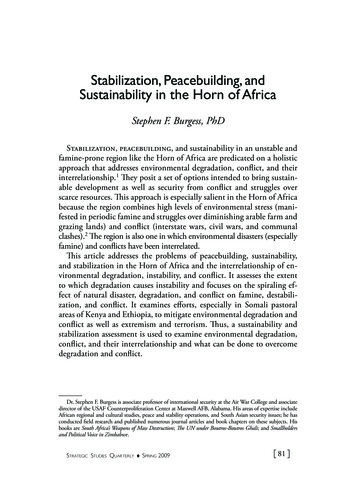
Transcription
Stabilization, Peacebuilding, andSustainability in the Horn of AfricaStephen F. Burgess, PhDStabilization, peacebuilding, and sustainability in an unstable andfamine-prone region like the Horn of Africa are predicated on a holisticapproach that addresses environmental degradation, conflict, and theirinterrelationship.1 They posit a set of options intended to bring sustain able development as well as security from conflict and struggles overscarce resources. This approach is especially salient in the Horn of Africabecause the region combines high levels of environmental stress (mani fested in periodic famine and struggles over diminishing arable farm andgrazing lands) and conflict (interstate wars, civil wars, and communalclashes).2 The region is also one in which environmental disasters (especiallyfamine) and conflicts have been interrelated.This article addresses the problems of peacebuilding, sustainability,and stabilization in the Horn of Africa and the interrelationship of en vironmental degradation, instability, and conflict. It assesses the extentto which degradation causes instability and focuses on the spiraling ef fect of natural disaster, degradation, and conflict on famine, destabili zation, and conflict. It examines efforts, especially in Somali pastoralareas of Kenya and Ethiopia, to mitigate environmental degradation andconflict as well as extremism and terrorism. Thus, a sustainability andstabilization assessment is used to examine environmental degradation,conflict, and their interrelationship and what can be done to overcomedegradation and conflict.Dr. Stephen F. Burgess is associate professor of international security at the Air War College and associatedirector of the USAF Counterproliferation Center at Maxwell AFB, Alabama. His areas of expertise includeAfrican regional and cultural studies, peace and stability operations, and South Asian security issues; he hasconducted field research and published numerous journal articles and book chapters on these subjects. Hisbooks are South Africa’s Weapons of Mass Destruction; The UN under Boutros-Boutros Ghali; and Smallholdersand Political Voice in Zimbabwe.Strategic Studies Quar terly Spring 2009Burgess.indd 81[ 81 ]2/2/09 2:40:49 PM
Stephen F. Burgess5FM "WJW :BGP*43"&"MFYBOESJB FSVTBMFN "NNBO*3"2* 3 " / 03%"/ BJSP,68"*5,VXBJU"M J[BI4"6%*& ( : 1 5.FEJOB"TXBO JEEBI.FDDB#")3"*/ 1FSTJBO0."/.BOBNB (VMG "CV%PIB3JZBEI%IBCJ(VMG PG 0NBO2"5"3 6/*5&% "3"#&.*3"5&4 .VTDBU"3"#*"0."/1PSU 4VEBO 3FE4FB0NEVSNBODARFUR,BTTBMB,IBSUPVN&3*53&"4 6 % " /4BOBB"EFO(VMG PG "EFO% EN 0DFBOFigure 1. Political map of Horn of Africa region. (Borders of the disputed regions ofDarfur, the Ogaden, Somaliland, and Puntland indicated here are approximate and are included for orientation purposes only. Some overlap exists between the claims of Somalilandand Puntland along their shared border. The inclusion of such labeling does not represent orimply recognition by the author or by any agency or department of the US government.)The Horn of Africa RegionThe “core” of the Horn of Africa refers to the area adjacent to wherethe “Horn” juts into the Arabian Sea and Indian Ocean and includesEthiopia, Somalia, Eritrea, and Djibouti. The core features a cultural clashbetween “lowland” Islamic pastoralists from Somali, Oromo, and other eth nic groups and “upland” Orthodox Christian farmers from Amharic andTigrayan ethnic groups. The struggle between uplanders and lowlanders has[ 82 ]Burgess.indd 82Strategic Studies Quar terly Spring 20092/2/09 2:40:51 PM
Stabilization, Peacebuilding, and Sustainability in the Horn of Africabeen going on for several hundred years and has centered on control overland and wealth.3The larger Horn refers to countries that have close relations with or arerivals of the core states, especially Sudan and Kenya, and to a lesser extentUganda. Sudan is especially important because of its rivalry for the pastcentury and a half with Ethiopia. Sudan features a core group of Arabspeaking Muslim farmers from the banks of the Nile and surroundingareas who have managed to control (often with force) vast outlying sec tions of the country composed mostly of nomadic pastoralists and somefarmers. The struggle between Sudan and Ethiopia began with the Mahdiin the late nineteenth century and resumed in the 1950s with the inde pendence of Sudan. Ethiopia tended to back southern Sudanese rebelswho were fighting against Sudanese government attempts to “Arabize”and “Islamize” them. Sudan tended to back Eritrean separatists who werefighting for independence and against Ethiopian annexation.Kenya fits into the Horn because of its relations with Somalia, Ethiopia,and Sudan. Kenya was a British settler colony from which the British pro jected power during the colonial era and attempted to control pastoralistareas in the north of the country (including Somali pastoralists). Kenyahas been a peacemaker in the region, especially in Somalia and Sudan.Uganda fits into the Horn because of its relations with Sudan and Kenyaand its pastoralist population (in the northeast) who move across borders.In addition, the Blue Nile and White Nile both flow through the region.The Horn of Africa features pastoralists, drylands, and semiarid topog raphy (80 percent of the more than five million square kilometers). Sixtytwo percent of land in the Horn of Africa is occupied by pastoralists, whoare 12 percent of the population of the region and who live on semiaridland with a lack of water.4All of the states mentioned came together to create the IntergovernmentalAuthority on Drought and Development (IGADD) in the mid-1980s todeal with famines, which were afflicting the region.5 In the mid-1990s,the IGADD became the Intergovernmental Authority on Development(IGAD) and became a peacemaking body, playing a role in the end ofconflicts in southern Sudan and Somalia and authorizing the develop ment of an early warning system to prevent or stop environmental degra dation and conflict.6The Horn is greatly influenced by Egypt, which has had long, close rela tions with the region. Egypt’s primary concern has been guaranteeing theStrategic Studies Quar terly Spring 2009Burgess.indd 83[ 83 ]2/2/09 2:40:52 PM
Stephen F. Burgessfree flow of the Nile for national survival and ensuring navigation throughthe Suez Canal and the Red Sea. Saudi Arabia has influence over Sudanand Somalia and has exported its version of “Wahhabist” Islam to theHorn. Yemen is just across the strategic strait (the Bab el-Mandeb) fromthe Horn and takes an interest in its affairs. Yemen has also been a crossingpoint for al-Qaeda from the Arabian Peninsula to the Horn.Islamic extremism exists in the Horn of Africa and has flowed downfrom the Arabian Peninsula. Osama bin Laden was welcomed to Sudanin the early 1990s by Islamist leader Husain al-Turabi and built al-Qaedathere. In 1996 the Sudanese regime asked bin Laden to leave. In 1993Islamic extremists arose in Somalia in opposition to US, UN, and Westernintervention. Today extremism persists among some members of the IslamicCourts Union (ICU), and foreign Islamic fighters have been fighting theEthiopians. However, it is uncertain if al-Qaeda has made serious inroadsinto Somalia. In Kenya and Tanzania, the discontent of coastal Muslimswho have been neglected by regimes dominated by non-Muslims fromthe interior led some to join al-Qaeda and participate in the 1998 em bassy bombings and the 2002 attacks on an Israeli hotel and airliner inMombasa.7 At issue is the degree of al-Qaeda presence today, especially inSomalia and coastal Kenya and Tanzania. In previously religion-tolerantEthiopia, reports have asserted that both Islamic extremism (especiallyWahhabism) and Orthodox Christian fundamentalism are growing.8Stabilization Challenges and State Failurein the Horn of AfricaState failure in the Horn of Africa has provided considerable materialfor research and literature.9 Somalia is the most obvious case.10 State dis integration in Uganda under Idi Amin in the 1970s and Milton Obote inthe early 1980s is also well known.11 In Sudan, the central government hastried to “conquer, Arabize, and Islamize” the South for most of half a cen tury, as well as ethnically cleanse Darfur and subdue other outlying regions,instead of seeking to build legitimacy—this has constituted state failure inthose regions.12 Less obvious cases of “partial failure” include Ethiopia inthe Somali Ogaden, Kenya in the Somali Northeast, and Uganda in theAcholi North (facing the Lord’s Resistance Army).13At the macro level, the Horn of Africa is a difficult region in which tobuild and sustain states. There are widely differing topographies (mountains,[ 84 ]Burgess.indd 84Strategic Studies Quar terly Spring 20092/2/09 2:40:52 PM
Stabilization, Peacebuilding, and Sustainability in the Horn of AfricaFigure 2. Topographical map of Horn of Africa regionsavanna, and desert) and modes of production (commercial and smallholderagriculture and pastoralism). Before the European colonial powers arrived,there were only two significant states extant—Amharic-Shoan Ethiopiaand Mahdist Sudan.14 Boundaries drawn and colonies created in the latenineteenth century have remained sources of contention. The coloniallegacy is one in which relatively strong states (e.g., Ethiopia, Sudan, andBritish settler Kenya) were surrounded by nonstate groupings (mainly pasto ralists). Indirect colonial rule in Uganda and Sudan meant little integration ofethnic groups, especially pastoralists. The division of Somalis into five colonialterritories helped to accentuate clan fissures.15Strategic Studies Quar terly Spring 2009Burgess.indd 85[ 85 ]2/2/09 2:40:53 PM
Stephen F. BurgessIn the Horn of Africa, pastoralists resisted state intervention and controlssuch as boundaries, fencing, and pest eradication programs and did not needstates as much as farmers did.16 In general, there was little environmentalcontrol or agricultural extension and livestock control in the region. Thus,there was little positive institutional interaction between pastoralists andstates. Therefore, the tasks of post-independence state building and regionalintegration were difficult in the vast lowland expanses of the Horn.17In the 1950s and 1960s, Ethiopia annexed Eritrea––which led to war––and came into rivalry with newly independent Sudan and Somalia, whichset the stage for a range of destabilization activities. Ethiopia supportedrebels in the southern Sudan, while Sudan supported the Eritrean libera tion movements. Somalia laid claim to the Ogaden in Ethiopia, whichled to an invasion and war in 1977–78. Somalia’s defeat and subsequentEthiopian subversion contributed to state decline, failure, and collapse.These rivalries paved the way for state failure, especially for Somalia andSudan, regime change in Ethiopia, and the independence of Eritrea. AfterEritrea became independent in 1993, it quickly came into conflict withits erstwhile ally, the Ethiopian People’s Revolutionary Democratic Front(EPRDF) regime in Ethiopia.At the intermediate level, all states in the region have suffered problemswith institutional viability and state weakness. Patronage networks devel oped and then shriveled in Somalia and Sudan in the 1960s and 1980s,leading to state failure. In Kenya under Pres. Daniel Arap Moi (1978–2002), patronage networks shrunk and ethnic conflict over land intensi fied, bringing warnings of possible state failure.18 In the 1960s Ugandanpresident Milton Obote shut out the predominant Buganda kingdomfrom patronage networks and removed the Kabaka as head of state, whichled to Idi Amin’s 1971 military coup and state disintegration.19At the micro level, all states in the region have suffered from shocks ofvarious sorts—including famine, economic downturns, and revolution—which contributed to state failure. The Ethiopian famines of 1973 and1984–85 contributed to regime changes (the overthrow of Emperor HaileSelassie in 1974 and Mengistu Haile Mariam in 1991). In the late 1970s,the revolutionary Dergue regime instituted land reform and attempted toradically reorganize farming, which disrupted traditional agricultural sys tems and productive capacity.20 The disruption and famine gave impetus tothe Eritrean People’s Liberation Front and the Tigrayan People’s Libera tion Front, which came to power six years later. The Somalia famine of[ 86 ]Burgess.indd 86Strategic Studies Quar terly Spring 20092/2/09 2:40:53 PM
Stabilization, Peacebuilding, and Sustainability in the Horn of Africa1991–92 was partly the result of state failure and conflict. The rise of clanwarlords, who used food to empower themselves, made the reconstitutionof the Somalian state all but impossible.21Stabilization Challenges in SomaliaThe case of state failure and collapse in Somalia (1990 to the present) isthe most pronounced of any in Africa and the world and has been examinedthoroughly by a number of scholars.22 At the macro or structural level, theprincipal problems have been pastoralist clans who have long contended forresources, the colonial misdivision of Somalis, and the resulting irredentism.Pre-colonial Somalia was characterized by pastoralist clans who contendedover water holes, grazing lands, and livestock and who raided sedentaryagriculturalists—poor social capital for the building of nation-states.23 Inthe scramble for Africa, Italy took southeastern Somali areas, while Britaintook northern and southwestern Somali areas and Ethiopia took the westernOgaden region.24 The Italians did little to build colonial administration andinfrastructure from 1900 to 1941, while the British put little into the north(Somaliland) from 1900 to 1961 and the south that it governed from 1941to 1961.From independence in 1961 until 1969, small elites struggled to create asuccessful Somali state but were unable to control contention and politicalchaos. They established patronage networks that drowned in a sea of cor ruption. They promised the recovery of Somali lands in Ethiopia, Kenya,and Djibouti but were unable to bring about the irredentist promise of alarger Somalia.The military coup of 1969 and the Siad Barre dictatorship were reactionsto the weakness and corruption of the new Somali state and the civilian elites’inability to bring promises to fruition. The Barre regime made a concertedeffort to strengthen and extend the state’s reach (e.g., they attempted to trans form pastoralists into fishers) and build the Somali nation. The adoptionof “scientific socialism” helped to bring Soviet assistance, including largeamounts of military aid. In 1977 and 1978 Somalia used that military aidto invade Ethiopia and take the Ogaden. Defeat in 1978 dealt a blow tothe Barre regime from which it never recovered.At the intermediate level of institutional viability and state weakness, dic tator Siad Barre established patron-client relations in the 1970s (with thehelp of Soviet aid) with the various clans. However, after the defeat in 1978,the switch from Soviet to American patrons, and economic downturn in theStrategic Studies Quar terly Spring 2009Burgess.indd 87[ 87 ]2/2/09 2:40:54 PM
Stephen F. Burgess1980s, the regime narrowed the range of clan clients until only Barre’s subclan of the Darod clan was benefiting.25 In April 1978 the Somali Salvationand Democratic Front launched guerrilla operations in southern Somaliawith Ethiopian support. In 1981, the Somali National Movement launcheda campaign in the north that would lead to the nominal independence ofSomaliland in 1991. Repression by the regime’s security system did notprove effective and actually backfired, increasing violent opposition. SiadBarre refused to negotiate with the opposition and reacted by narrowing hispower base to three sub-clans of the Darod clan.26At the micro level, the United States suddenly withdrew aid to the Barreregime in 1988 as the Cold War was coming to an end. The evaporationof resources crippled the state and enabled the rebels’ advance, which ledto regime failure in the course of 1990 and collapse in January 1991.Siad Barre continued to refuse to negotiate, even as opposing rebel groupsclosed in on the capital, Mogadishu.After the collapse, the inability of opposition movements and clans toreach agreement led to the failure of the Somalian state and the rise of thewarlords.27 The failed state and clan warfare in Somalia immediately hadramifications for environmental sustainability and the welfare of Somalis.The great Somalia famine of 1991–93 was a direct result of state collapseand the conduct of the warlords. Warlords seized food from Somali farmersand relief agencies and used the proceeds to buy weapons, provide patron age, and grow in strength. With no state, fights over grazing lands and waterholes went unresolved. As clan warfare intensified, there was no state to stepin to resolve disputes. The interconnectedness of state failure, warfare, andenvironmental degradation and famine became clear.Efforts were mounted to reconstitute the Somalian state, but all failed. In1993, the United States and the UN Operation in Somalia (UNOSOM II)tried to gain agreement on rebuilding the state. The special representative ofthe UN secretary-general and chief of mission, ADM Jonathan Howe, andhis advisors were determined to take a “bottom up” approach to reconstitut ing the Somalian state. In March 1993, they negotiated an agreement with arange of local leaders to build local governments, then provincial governments,and then the central state. However, Howe and his colleagues attempted tocircumvent the powerful warlords after already agreeing in principle to a “topdown” power-sharing arrangement among them. The warlords rejected thebottom-up approach and mounted an insurgency that eventually drove theUnited States and the United Nations out of Somalia.28[ 88 ]Burgess.indd 88Strategic Studies Quar terly Spring 20092/2/09 2:40:54 PM
Stabilization, Peacebuilding, and Sustainability in the Horn of AfricaAfter US and UN withdrawal, the warlords continued fighting eachother in and around Mogadishu for more than a decade. In contrast, peaceprevailed in Somaliland (in the north of Somalia), which declared inde pendence in May 1991 and held democratic elections in 2003. However,Somaliland has failed to win recognition as a sovereign state. In 1998,Puntland (in the northeast of Somalia) declared autonomy from Mogadishuunder Pres. Abdullahi Yusuf Ahmed and has remained relatively peaceful(though there have been clashes with Somaliland forces over the contestedSool region). In 2004, Yusuf was elected by his peers as president of theTransitional Federal Government (TFG) for all of Somalia. Electionswere held in Puntland in January 2005, and Mohamed Muse Hersi wasvoted president.After 1993, peacemaking in Somalia fell to the IGAD under Kenyan andDjiboutian leadership. In 2004 the TFG and Somali Transitional Federal Par liament (TFP) were formed and elected President Yusuf. Each of Somalia’sfour major clans was allocated 61 seats in the parliament, while an alliance ofminority clans received 31 seats. The TFP and TFG agreed on a charter forthe reconstitution and governing of the Somali state. A split occurred betweenPresident Yusuf’s group (based in the Darod clan) and a Mogadishu-basedfaction (mainly the Hawiye clan). At the beginning of 2006, the split ended,and the TFG moved to Baidoa, Somalia.In early 2006, the Islamic Courts Union arose as an armed group and byJune defeated the warlords in and around Mogadishu. By September theICU controlled much of Somalia outside Somaliland and Puntland as wellas Baidoa, where the Ethiopian army protected the TFG. In December2006, the Ethiopians launched a counteroffensive and drove the ICUout of Mogadishu and other major centers. In February Uganda sent 400troops as an advance contingent of 1,600 peacekeepers to Mogadishu aspart of the African Union Mission to Somalia (AMISOM); Nigeria, Ghana,and Malawi failed to send peacekeepers because of continuing violence. InMarch the TFG moved to Mogadishu, which was rocked by violence thatdrove tens of thousands out of the city. Eritrea, in its feud with Ethiopia, hasarmed and trained the ICU as part of a coalition dedicated to driving theEthiopian army and the TFG out of Somalia. At issue is whether or not theTFG can survive and the Ethiopian army can be replaced by African Union(AU) peacekeepers.Francois Grignon, Africa director of the International Crisis Group(ICG), finds that the conflict in Somalia is a greater challenge than theStrategic Studies Quar terly Spring 2009Burgess.indd 89[ 89 ]2/2/09 2:40:54 PM
Stephen F. Burgessconflict in the African Great Lakes region (including the DemocraticRepublic of the Congo). He has been pessimistic about the prospect ofEthiopia holding Mogadishu for the TFG and even more so about theEthiopian army being replaced by AU peacekeepers or a new Somalianarmy.29 Lt Col Scott Rutherford, US defense attaché to Kenya, observedthat the longer Ethiopia meddles in Somali affairs, the longer it will takethe TFG to become independent.30Stabilization Challenges in SudanSudan is a state that has failed though it has never collapsed. Sinceindependence in 1956, the government in Khartoum has been unableto achieve legitimacy in vast outlying areas of Africa’s largest country. In stead, the regime has mostly engaged in repression, which has devastatedthe South and other areas. The civil war in the South, 1955–72 and 1983–2005, has contributed to massive dislocation of farmers and pastoralistsand to famines that have killed hundreds of thousands of people (as wellas livestock). Planted landmines have inhibited agricultural and pastoralactivities in many parts of the South. Genocide in Darfur has broughteven greater dislocation and death in a shorter period of time.31At the macro level, the slave trade (especially in the nineteenth cen tury) by the Arab North in the African South (and other regions) createdhegemonic relations that have endured until today.32 In the 1880s and1890s, the Mahdist state fought against nonbelievers in outlying regionsthat it claimed. The British inherited the tensions and minimally man aged Sudan as a “condominium” of Egypt, with the goal of protectingthe Nile and the Suez Canal. For much of the period, the North and theSouth were separate entities. However, as independence approached inthe early 1950s, they were thrown together by the British. In the early1950s, the northerners’ old hegemonic tendencies reemerged as theyattempted to spread Islam as the religion and Arabic as the language ofinstruction in the South.33In the two North-South civil wars, the rebels were supported at varioustimes by Ethiopia, Uganda, Kenya, and other states.34 At the institutionallevel, the Sudanese government excluded the South and other regionsfrom patronage networks that were established under successive dicta tors and during brief electoral democratic interludes in the mid-1960sand mid-1980s. From 1972 to 1983, peace prevailed—the only periodin which Sudan emerged from state failure. In the late 1970s and early[ 90 ]Burgess.indd 90Strategic Studies Quar terly Spring 20092/2/09 2:40:54 PM
Stabilization, Peacebuilding, and Sustainability in the Horn of Africa1980s, growing indebtedness led to state decline.35 During the 1980s, aseries of economic shocks and the resumption of the North-South civilwar in 1983 led Sudan to sink back into state failure. In 1989, Gen Omaral-Bashir staged a military coup, which deepened state failure. The Islamistmilitary regime intensified its war against the South, with help from grow ing oil revenues in the late 1990s, but was unable to defeat the SudanesePeople’s Liberation Movement and army. The impasse and interventionby international peacemakers in the early 2000s led to the negotiation ofthe Comprehensive Peace Agreement (CPA), which went into effect inJuly 2005 and which promises a referendum for the South in July 2011to decide whether to become independent or remain part of Sudan. Thefuture of North-South relations remains uncertain.36The same symptoms of state failure that the Khartoum regime had ex hibited towards the South could be observed in its relations with Darfurand other outlying regions. In 2003 and 2004, the government dispatchedthe janjaweed—pastoralist militias who were already struggling with Darfurfarmers over diminishing land37—to ethnically cleanse Darfur so that vari ous rebel movements would lose their base of support. Also, the janjaweedmilitias have many mercenaries.38 The result has been a genocide in whichhundreds of thousands have been killed or raped and millions displaced since2003–04 and in which widespread atrocities have continued ever since. Asin the case of the South, the intervention of international peacemakers hasbeen required to put an end to Khartoum’s abusive behavior.39Francois Grignon finds that the CPA between North and South Sudan isin danger. Darfur is a dramatic humanitarian catastrophe, but it is really asmokescreen for the real power struggle between North and South. However,if Khartoum loses Darfur, it stands a good chance of losing the South.40Solomon Gomes of the AU Peace and Security Commission finds thatthe Northern Sudanese are “playing for time” and that the AU and inter national community must be wary of Khartoum-sponsored militia groupsin southern Sudan and must be prepared for the secession of the Southfollowed by a resumption of hostilities by Khartoum. If the South secedes,Darfur will seek the same route.41 Gomes notes that Khartoum acceptedaspects of the Darfur Peace Agreement and now the hybrid UN/AU force.However, the problem now is persuading the government and the fractiousDarfur rebel movements to meet and discuss. In the meantime, the violenceand humanitarian catastrophe continue.Strategic Studies Quar terly Spring 2009Burgess.indd 91[ 91 ]2/2/09 2:40:55 PM
Stephen F. BurgessIn regard to stabilizing Somalia and Sudan, Gomes observes that thePeace and Security Commission (as the “locomotive” for action) has theresponsibility to inform the Peace and Security Council and the entireAU membership regarding the “pulse” in conflict zones. However, the com mission is understaffed and limited in taking action. It provides reports, forexample, from Sudan and Chad but cannot take action. Another problemis a lack of authority; for example, the AU has called on all rebel move ments to leave Chadian territory but has been unable to enforce its request.Gomes believes that the AU should leverage support for Chad’s interestsfrom France and the European Union (EU). The diplomatic track on theChad-Sudan conflict has been slow to materialize and has only come tofruition lately through French leadership.42Stabilization Challenges in Ethiopia’s Ogaden RegionSince annexing the Ogaden in the late 1800s, the Ethiopian state hastraditionally failed to reach out to pastoralists in the Somali Ogaden regionand to other pastoralists, including Oromo and Borana herders.43 The prob lem of weakness and failure has been based upon the bias of the Ethiopianstate in favor of highland Ethiopian Orthodox farmers versus lowland Islamicpastoralists. Also, Ethiopian suspicions about the loyalties of Ogaden Somalisrose in the 1960s, reached a crescendo during the 1977–78 Ogaden war, andhave persisted ever since.In 1991, the Tigrayan-dominated Ethiopian People’s RevolutionaryDemocratic Front regime took power and instituted a system of ethnicfederalism that promised autonomy and self-rule to the Ogaden Somalis,Oromos, and others.44 If properly instituted, ethnic federalism would haveenabled the various ethnic pastoralist groups to look after their own devel opment needs. However, the EPRDF regime has kept a tight rein on thefederal regions, especially since the 1998–2000 war with Eritrea. The lack ofautonomy helps to explain the revived insurgencies of the Ogaden NationalLiberation Front (ONLF) and the Oromo Liberation Front (OLF). Basicgovernment distrust of Oromos and Ogaden Somali pastoralists continuesin spite of ongoing projects for the lowlands and pastoralists by governmentand international development agencies and nongovernmental organizations(NGO). Meanwhile, the number of people and livestock continues to grow,as do sustainability and stabilization challenges.45The ONLF and OLF continue to operate against the government andits forces. The killing of nine Chinese oil workers and 65 Ethiopians by the[ 92 ]Burgess.indd 92Strategic Studies Quar terly Spring 20092/2/09 2:40:55 PM
Stabilization, Peacebuilding, and Sustainability in the Horn of AfricaONLF showed a level of sophistication that points to Eritrean involvement.46The escalation of hostilities in the Ogaden has created a humanitarian crisisin which pastoralists are finding it increasingly difficult to survive.47 Themassacre of oil workers has led Ethiopia to increase its military operations,made aid programs difficult to sustain, and caused problems for governmentofficials and international aid agencies. The International Committee of theRed Cross has been experiencing trouble, and the United Nations Develop ment Program (UNDP) has been considering pulling out of the Ogaden,even though the humanitarian situation has deteriorated rapidly.48Stabilization Challenges in Pastoral Areas of Kenya and UgandaKenya has had particular problems relating to Somali pastoralists ineastern Kenya. In the 1960s, Somalis fought against incorporation intoKenya and were regarded as either nationalist secessionist guerrillas (bySomalis) or merely bandits (by the government). In the colonial era, theBritish did not incorporate Somalis living in Kenya into the prevailingorder. At independence, the British reversed previous colonial policy anddecided to force unity among
leading to state failure. In Kenya under Pres. Daniel Arap Moi (1978- 2002), patronage networks shrunk and ethnic conlict over land intensi ied, bringing warnings of possible state failure. 18 In the 1960s Ugandan president Milton Obote shut out the predominant Buganda kingdom from patronage networks and removed the Kabaka as head of state .

